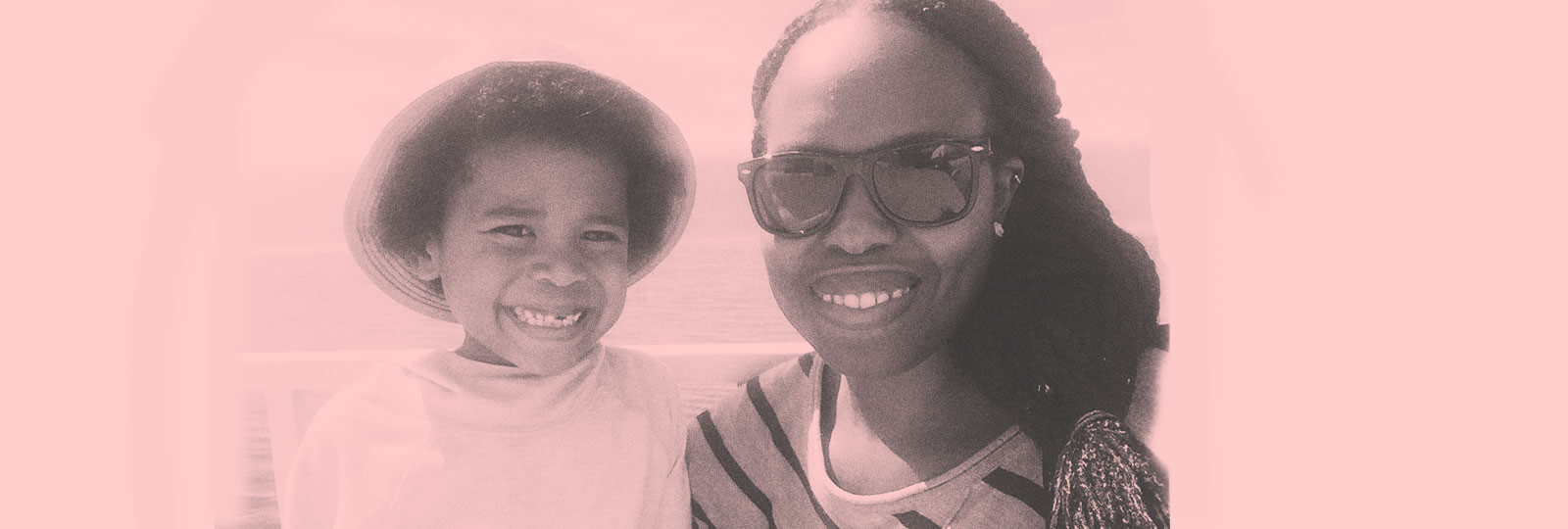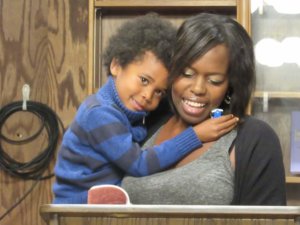

First Person
The Realities of Parenting a Black Son
Motherhood is full of joy and heartbreak. But for a Black mother in America, it also means fiercely protecting her child by fending off an unrelenting onslaught of racism and ignorance.
This article was made possible because of the generous support of DAME members. We urgently need your help to keep publishing. Will you contribute just $5 a month to support our journalism?
Eight moments in the life of a Black mother:
1. You and your 4-year old son live in Los Angeles, California. You enjoy your life here; your friends, your family—the balmy, sunny weather and diversity; how, when you walk outside your house you see people of all shades, sexual orientations, and genders. There is no judgment; difference is normal. But the price of living in this mecca is the high cost of living, and, as a single mom working as a freelance writer, you have realized you need a better job to give your son the lifestyle you would like.
The only thing your graduate degree has prepared you for is to write and be a college professor. Competition for jobs, however, is fierce in Los Angeles, and you know you will have to be much more advanced in your career to land a professorship at any university here. When you are asked to apply to a professorship at a small college on the east coast, you decide to apply for five other professorships to make the massive work-load—transcripts, letters of recommendation, artistic philosophy, teaching philosophy, and writing sample—worth it. After three rounds of interviews, you are offered an assistant professorship in Lincoln, Nebraska, a Midwestern town halfway across country from your West Coast home.
The first thing you do after saying yes to the job is go online and look up all the preschools in the city you will soon inhabit. You know, from living in Los Angeles, that the wait lists for preschools are often longer than the wait lists for any Ivy League school. You narrow your list to six reputable ones—all Montessori and Reggio based. You call and ask about their educational curriculum. They all sound great. Your last question, of course, is if they have any Black students. You do not have the luxury of not asking this, of not being direct; of beating around the bush. You have to know that your son will not be the only person in his school who looks like him. You know, from your own experience, the dangerous vulnerability of being the only one.
Of the six schools you call, only one says that they have any Black students—five children out of 150. None of the schools have any permanent, full-time Black teachers on staff. You think of the ramifications of this. Common sense—and if you don’t buy that, studies, as well—have shown that children do better when they can see older role models who look like them, that teachers of color are necessary for development and growth.

The author and her son
2. When you arrive in your new city, you realize this is the first time in your life you have seen Confederate flags waving proudly. The first time you have seen bumper stickers for the presidential candidate who has made it clear you and your kind are not welcome; that you and your kind should be sexually assaulted; that you and your kind are criminals and “bad hombres.” For the first time in your life, you knock on the doors of neighbors to prospective houses, to see how they react to you. With the help of a queer couple who has befriended you, and who did this when they first moved to this town, you learn how to read neighborhood clues to see where you will be safe. This is the essence of straight white privilege: you do not have to worry that your neighbors will be violent towards you because of the color of your skin; you do not carefully have to assess each neighborhood for signs of racism or homophobia to make sure you and your children will be safe.
3. When you pick up your 4-year-old son from preschool, his hair his full of dirt and leaves. The white assistant teacher tells you that the staff had raked piles of leaves for the students to jump into. But they could not comb your son’s hair because the texture of his black hair is too different, too coarse. You tell the assistant teacher you comb his hair every morning and night just fine. There is a pause, and then the assistant teacher wanders away. You remember how your father told you how, over 30 years ago when your parents came to this country and settled in another Midwestern town, the teachers at the church Sunday school refused to comb you and your sister’s hair or change you and your sister’s diapers because they did not want to touch Black babies. You thought things had changed since then. You guess you are wrong.

4. On the playground, you and your 4-year-old son play in the sandbox. An older white girl, about 11 years old, begins to play with your son. You tell her mother that it is amazing how well her older child is playing with your young son; she is so considerate, you say. The older girl’s mother tells you her daughter is good now, but she used to have problems with the coloreds. Your brain stutters; you tell yourself she meant colors. So you ask her what problem did she have with colors—painting? Drawing?
The girl’s mother tells you the problem was with colored people. The girl’s father, see, is very racist and the girl picked it up from him. She, the mother, had to work to stop it and tell her daughter that the coloreds were just like them. They were just the same, under that brown. Why, her best friend was Black. You are stunned into silence. You have never been called colored people. You feel like you have traveled back in time thirty years. You manage to ask her if she has any other Black friends. She says no. You wonder it that other Black woman would say that this white woman was her friend. You think not. You wonder if you should explain to this white woman exactly everything that is problematic about what she just said; if you should waste your time and energy again educating yet another white person about race and racism in order for them to treat you like a person—the constant burden of people of color everywhere. Or should you not bother, move through this moment like it hasn’t happened before and won’t happen again in another form with another person just a few minutes from now? They are unbothered. It only affects you.
You realize to survive here you cannot hold on; you must learn to let go. But you can’t. Because for you and your son, these things are not peripheral; these things—how these people here see your skin—is the difference between whether they will choose to pull the trigger, or to holster their guns and treat you like a person; these things are life and death. Because you are realizing that these are the people who will be the parents of the children your son goes to school with; these are the doctors and lawyers and police in your town. And this is only the mildest of racism; this woman actually thinks she is woke. You shudder.
5. At home, your 4-year old son tells you that another preschool teacher told him that if he washes his brown skin he will grow lighter and not be black. You are livid. You want to throw things. You want to curse at people. You remember how you and your sisters still feel the weight of comments exactly like this, over 30 years later. You thought things would be different now. You wonder whether you need to speak to the director, the head teachers, the assistant teachers, or all three. But you know if you rage, they will shut down. You know that this is the bitter pill Black people must swallow; you cannot express your emotions because you have to protect the emotions of the white people involved in the situation, otherwise they will shut down; they will get defensive.
You, the Black person, must always forgive, must always turn the other cheek, must always be the bigger person. You must use this as a teachable moment and explain to the director and the teacher why such comments are unacceptable and hurtful. You must explain that they must create training in diversity and inclusivity, both for the teachers and the students. You must lay out, step by step, why things like this cannot be said; why things like this can never happen again. The preschool director refuses to enact any changes in the school program to end the racism that affected your son. You cry. You dry your eyes. You pick yourself up and advocate for your son again. You create a three-part plan for diversity and inclusion and present it to the school. After a week of emailing and prevarication, they agree to hold a diversity and inclusion seminar. You realize this will be the next 12 years of your life.
6. On your flight from Omaha to Los Angeles, the fully grown white women in the seat in front of you repeatedly turns around and tries to attack your 4-year-old son. You tell her to stop, to control herself, and she laughs at you and keeps trying to hit your son. The airline staff does nothing about this other than take a report; you have to arrange with other generous passengers to switch seats away from the assaulting woman yourselves. The police, when you report it say the woman has not committed a crime and there is nothing they can do. You remember that white women bought and sold slaves too; jeered and spat at the little afro-puffed girls and afroed boys desegregating the schools; laughed and picnicked at lynchings of Black men, women, and children too. You are not surprised, as social movements ebb and flow, at the erasure of Black women, of people of color; at the pink pussyhats on Harriet Tubman.
7. You are trying to find the right kindergarten for your son. The schools with the highest great-school rankings have no Black students. The ones with any amount of diversity are ranked the lowest. This, it seems, is always the choice: better education versus diversity. A friend tells you that a fight broke out at her son’s school and the teacher walked over to the only Black boy in the group of boys and said “The next time you cause trouble, boy, I’m going to call the police on you.” The boy was 6 years old, your friend tells you. The school, of course, never bothered to tell his mother. You have seen this story repeated in classrooms all around the country. Sometimes, the Black baby is handcuffed or jailed; sometimes beaten, sometimes killed. For Black children, you know the preschool to prison pipeline is very real. You thought you could protect your baby through your presence, and you are already hyper-vigilant. You have gone to every back to school/parent teacher conference/PTA meeting/school function. You talk to all the teachers. You talk to the parents. You want them to know there is someone paying attention to make sure your son is treated equally and not scapegoated or blamed. To make sure he does not experience deliberate racism or unconscious microaggressions.
But still, it is happening. Your vigilance is not enough. You do not know how you will find the strength to fight for your son to be seen as a person equal of respect and care for the next 12 years of the school system here. You do not know what the extent of the traumatic effect of this constant ongoing racism will be on his psyche; you do, however, know that the effects of racism are very real. You think seriously about homeschooling. You wonder if you can handle working full-time and home-schooling full time. You wonder if it is possible if you can find a school where your son will be safe and not scapegoated or beaten down by casual racism.
8. Your son is 5 years old and having nightmares. He wakes up crying. “Mama,” he tells you when he calms down, “I had a dream that Donald Trump came to hurt us. It was so scary.” You reassure your son that Donald Trump isn’t going to hurt him, that no one is going to hurt him, that mama is here to protect him. “But I heard him say so,” your son protests. “I heard him say on the news brown people are bad people and they need to leave now or he is going to hurt us.” You try to find the words to reassure your son, to explain things you don’t understand yourself.
Your job is to protect him. You job is to keep him safe. But how can you do this in a country, in a time where in every space your son enters, the presence of violence against him is not an if, but a guarantee? When, just by living, he is becoming conscious of the many facets of racism and confusedly, painfully, like the child he is, trying to figure this out himself?
Before you go, we hope you’ll consider supporting DAME’s journalism.
Today, just tiny number of corporations and billionaire owners are in control the news we watch and read. That influence shapes our culture and our understanding of the world. But at DAME, we serve as a counterbalance by doing things differently. We’re reader funded, which means our only agenda is to serve our readers. No both sides, no false equivalencies, no billionaire interests. Just our mission to publish the information and reporting that help you navigate the most complex issues we face.
But to keep publishing, stay independent and paywall free for all, we urgently need more support. During our Spring Membership drive, we hope you’ll join the community helping to build a more equitable media landscape with a monthly membership of just $5.00 per month or one-time gift in any amount.


















































































